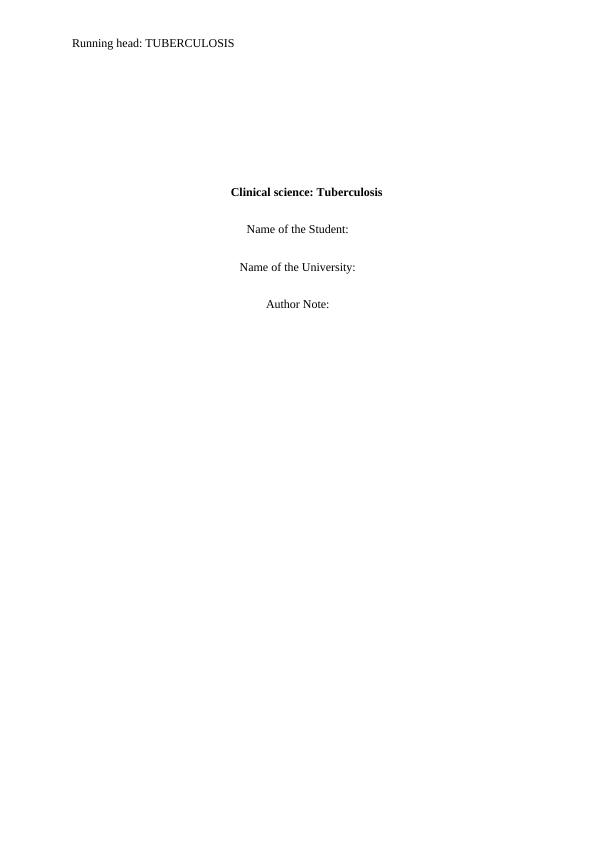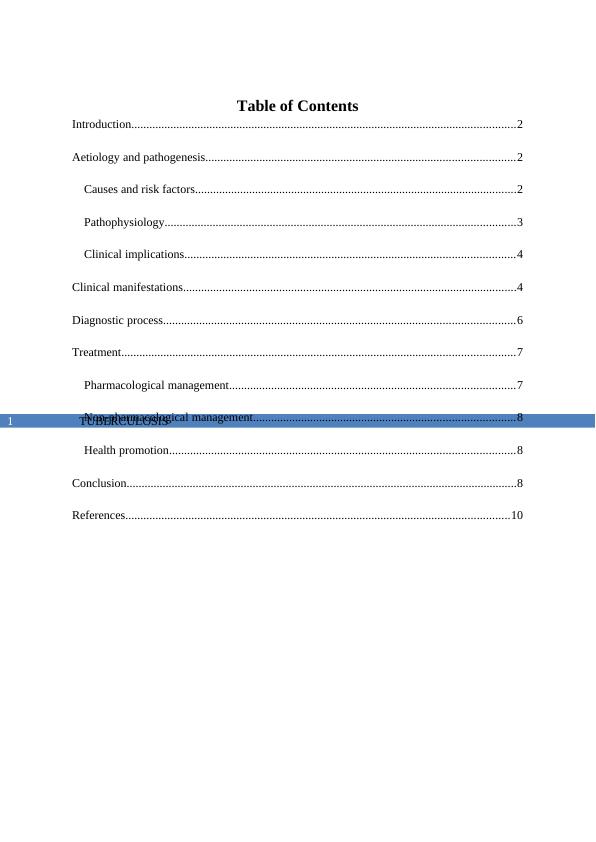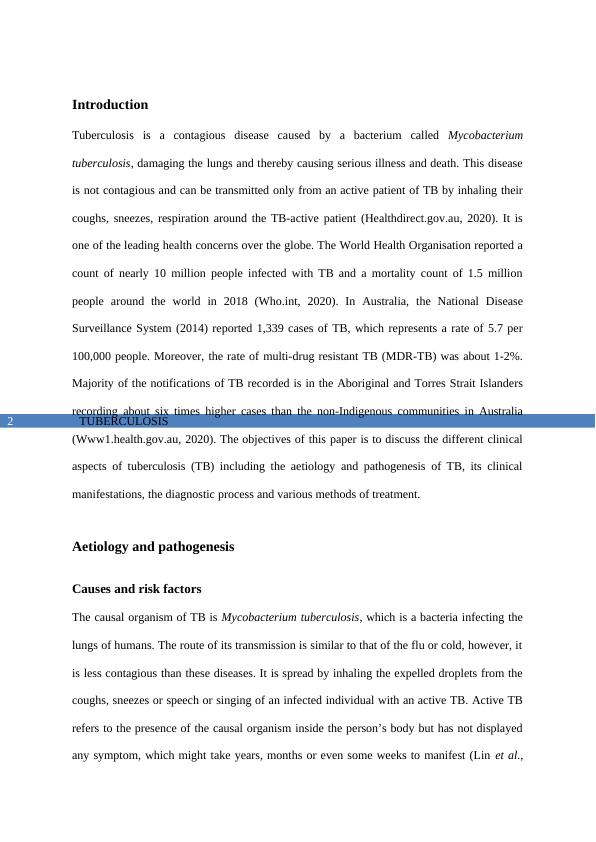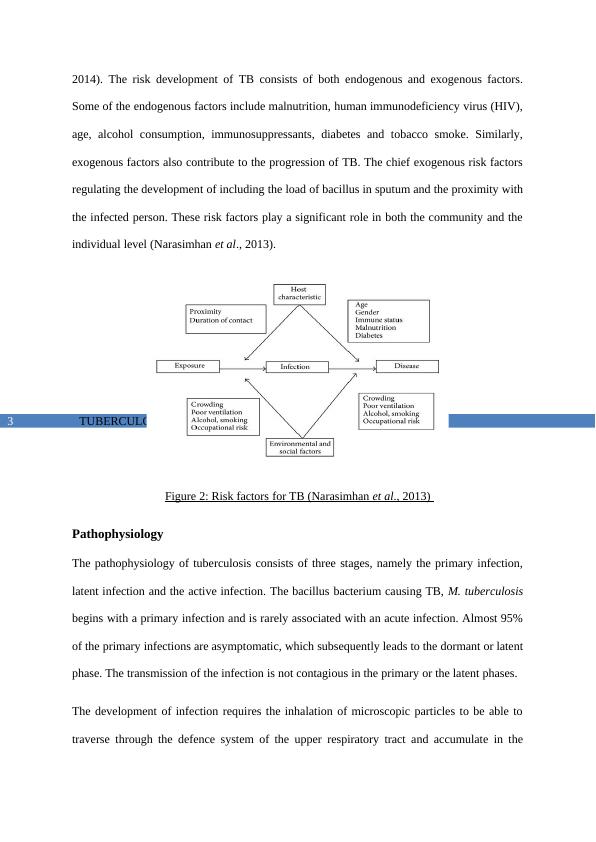Tuberculosis is a contagious disease caused by a bacterium called Mycobacterium tuberculosis
Added on 2022-09-16
14 Pages3085 Words14 Views
Running head: TUBERCULOSIS
Clinical science: Tuberculosis
Name of the Student:
Name of the University:
Author Note:
Clinical science: Tuberculosis
Name of the Student:
Name of the University:
Author Note:

TUBERCULOSIS1
Table of Contents
Introduction................................................................................................................................2
Aetiology and pathogenesis.......................................................................................................2
Causes and risk factors...........................................................................................................2
Pathophysiology.....................................................................................................................3
Clinical implications..............................................................................................................4
Clinical manifestations...............................................................................................................4
Diagnostic process.....................................................................................................................6
Treatment...................................................................................................................................7
Pharmacological management...............................................................................................7
Non-pharmacological management.......................................................................................8
Health promotion...................................................................................................................8
Conclusion..................................................................................................................................8
References................................................................................................................................10
Table of Contents
Introduction................................................................................................................................2
Aetiology and pathogenesis.......................................................................................................2
Causes and risk factors...........................................................................................................2
Pathophysiology.....................................................................................................................3
Clinical implications..............................................................................................................4
Clinical manifestations...............................................................................................................4
Diagnostic process.....................................................................................................................6
Treatment...................................................................................................................................7
Pharmacological management...............................................................................................7
Non-pharmacological management.......................................................................................8
Health promotion...................................................................................................................8
Conclusion..................................................................................................................................8
References................................................................................................................................10

TUBERCULOSIS2
Introduction
Tuberculosis is a contagious disease caused by a bacterium called Mycobacterium
tuberculosis, damaging the lungs and thereby causing serious illness and death. This disease
is not contagious and can be transmitted only from an active patient of TB by inhaling their
coughs, sneezes, respiration around the TB-active patient (Healthdirect.gov.au, 2020). It is
one of the leading health concerns over the globe. The World Health Organisation reported a
count of nearly 10 million people infected with TB and a mortality count of 1.5 million
people around the world in 2018 (Who.int, 2020). In Australia, the National Disease
Surveillance System (2014) reported 1,339 cases of TB, which represents a rate of 5.7 per
100,000 people. Moreover, the rate of multi-drug resistant TB (MDR-TB) was about 1-2%.
Majority of the notifications of TB recorded is in the Aboriginal and Torres Strait Islanders
recording about six times higher cases than the non-Indigenous communities in Australia
(Www1.health.gov.au, 2020). The objectives of this paper is to discuss the different clinical
aspects of tuberculosis (TB) including the aetiology and pathogenesis of TB, its clinical
manifestations, the diagnostic process and various methods of treatment.
Aetiology and pathogenesis
Causes and risk factors
The causal organism of TB is Mycobacterium tuberculosis, which is a bacteria infecting the
lungs of humans. The route of its transmission is similar to that of the flu or cold, however, it
is less contagious than these diseases. It is spread by inhaling the expelled droplets from the
coughs, sneezes or speech or singing of an infected individual with an active TB. Active TB
refers to the presence of the causal organism inside the person’s body but has not displayed
any symptom, which might take years, months or even some weeks to manifest (Lin et al.,
Introduction
Tuberculosis is a contagious disease caused by a bacterium called Mycobacterium
tuberculosis, damaging the lungs and thereby causing serious illness and death. This disease
is not contagious and can be transmitted only from an active patient of TB by inhaling their
coughs, sneezes, respiration around the TB-active patient (Healthdirect.gov.au, 2020). It is
one of the leading health concerns over the globe. The World Health Organisation reported a
count of nearly 10 million people infected with TB and a mortality count of 1.5 million
people around the world in 2018 (Who.int, 2020). In Australia, the National Disease
Surveillance System (2014) reported 1,339 cases of TB, which represents a rate of 5.7 per
100,000 people. Moreover, the rate of multi-drug resistant TB (MDR-TB) was about 1-2%.
Majority of the notifications of TB recorded is in the Aboriginal and Torres Strait Islanders
recording about six times higher cases than the non-Indigenous communities in Australia
(Www1.health.gov.au, 2020). The objectives of this paper is to discuss the different clinical
aspects of tuberculosis (TB) including the aetiology and pathogenesis of TB, its clinical
manifestations, the diagnostic process and various methods of treatment.
Aetiology and pathogenesis
Causes and risk factors
The causal organism of TB is Mycobacterium tuberculosis, which is a bacteria infecting the
lungs of humans. The route of its transmission is similar to that of the flu or cold, however, it
is less contagious than these diseases. It is spread by inhaling the expelled droplets from the
coughs, sneezes or speech or singing of an infected individual with an active TB. Active TB
refers to the presence of the causal organism inside the person’s body but has not displayed
any symptom, which might take years, months or even some weeks to manifest (Lin et al.,

TUBERCULOSIS3
2014). The risk development of TB consists of both endogenous and exogenous factors.
Some of the endogenous factors include malnutrition, human immunodeficiency virus (HIV),
age, alcohol consumption, immunosuppressants, diabetes and tobacco smoke. Similarly,
exogenous factors also contribute to the progression of TB. The chief exogenous risk factors
regulating the development of including the load of bacillus in sputum and the proximity with
the infected person. These risk factors play a significant role in both the community and the
individual level (Narasimhan et al., 2013).
Figure 2: Risk factors for TB (Narasimhan et al., 2013)
Pathophysiology
The pathophysiology of tuberculosis consists of three stages, namely the primary infection,
latent infection and the active infection. The bacillus bacterium causing TB, M. tuberculosis
begins with a primary infection and is rarely associated with an acute infection. Almost 95%
of the primary infections are asymptomatic, which subsequently leads to the dormant or latent
phase. The transmission of the infection is not contagious in the primary or the latent phases.
The development of infection requires the inhalation of microscopic particles to be able to
traverse through the defence system of the upper respiratory tract and accumulate in the
2014). The risk development of TB consists of both endogenous and exogenous factors.
Some of the endogenous factors include malnutrition, human immunodeficiency virus (HIV),
age, alcohol consumption, immunosuppressants, diabetes and tobacco smoke. Similarly,
exogenous factors also contribute to the progression of TB. The chief exogenous risk factors
regulating the development of including the load of bacillus in sputum and the proximity with
the infected person. These risk factors play a significant role in both the community and the
individual level (Narasimhan et al., 2013).
Figure 2: Risk factors for TB (Narasimhan et al., 2013)
Pathophysiology
The pathophysiology of tuberculosis consists of three stages, namely the primary infection,
latent infection and the active infection. The bacillus bacterium causing TB, M. tuberculosis
begins with a primary infection and is rarely associated with an acute infection. Almost 95%
of the primary infections are asymptomatic, which subsequently leads to the dormant or latent
phase. The transmission of the infection is not contagious in the primary or the latent phases.
The development of infection requires the inhalation of microscopic particles to be able to
traverse through the defence system of the upper respiratory tract and accumulate in the

End of preview
Want to access all the pages? Upload your documents or become a member.
Related Documents
Comprehensive Report on Tuberculosis Diseaselg...
|8
|2604
|28
Tuberculosis: Etiology, Pathogenesis, Clinical Manifestation, and Treatmentlg...
|15
|3096
|65
Clinical Update: Tuberculosis Assignment 2022lg...
|15
|3835
|40
Tuberculosis: Background, Strategies, Policies, and Ethical Considerationslg...
|9
|3120
|40
TB in Hong Kong: Types, Effects, Prevention and Controllg...
|12
|4533
|483
History of Tuberculosis - doclg...
|12
|2860
|252
